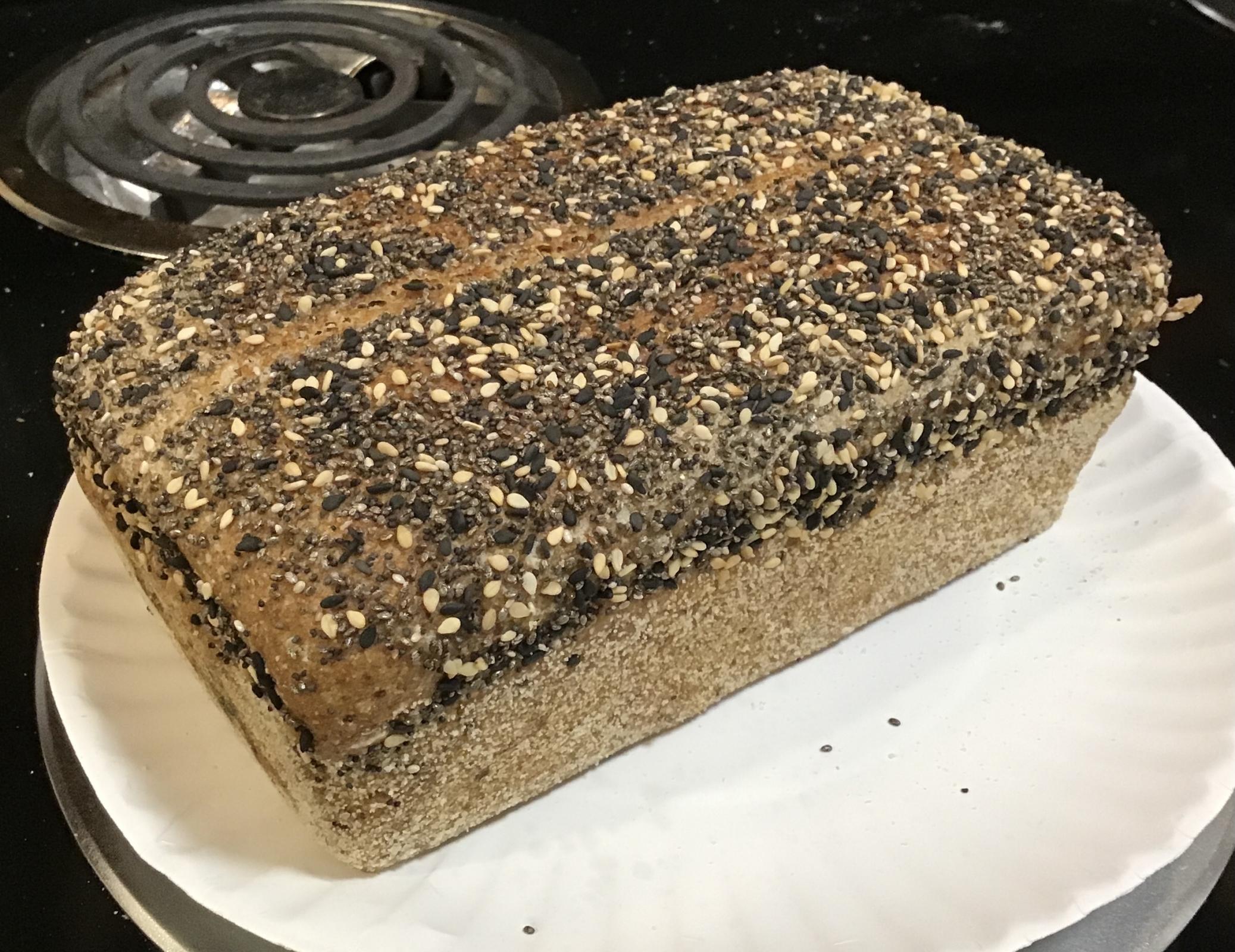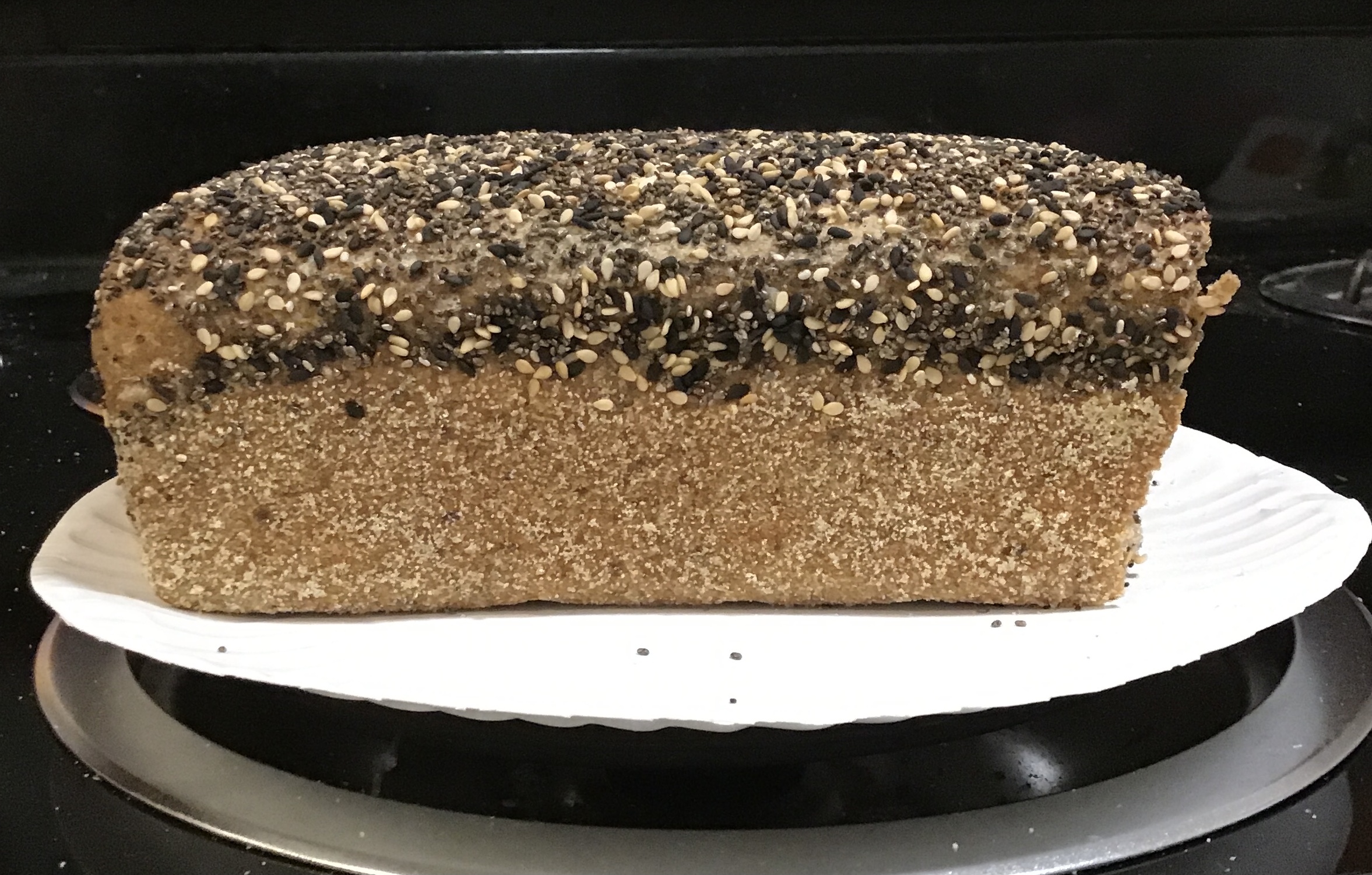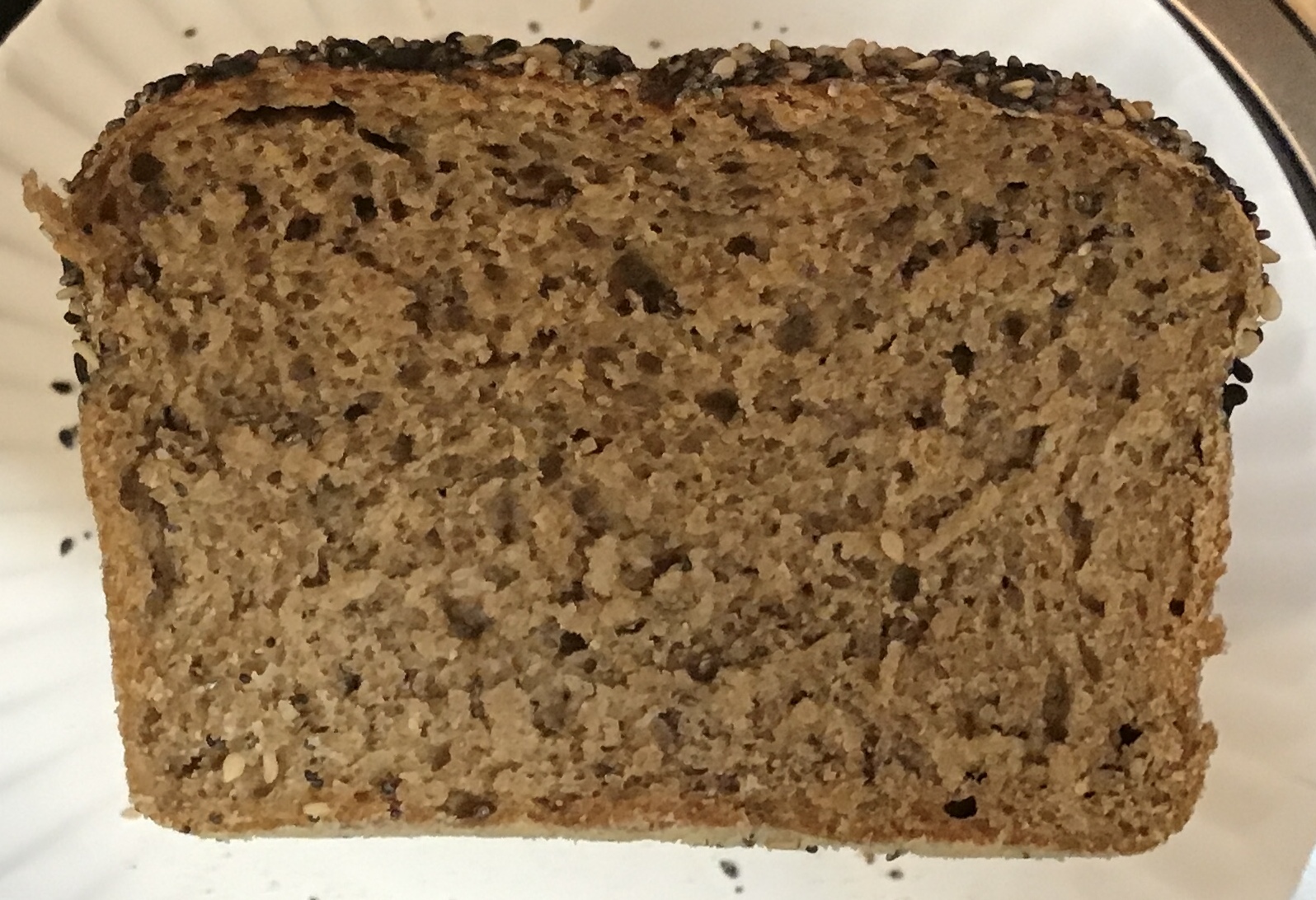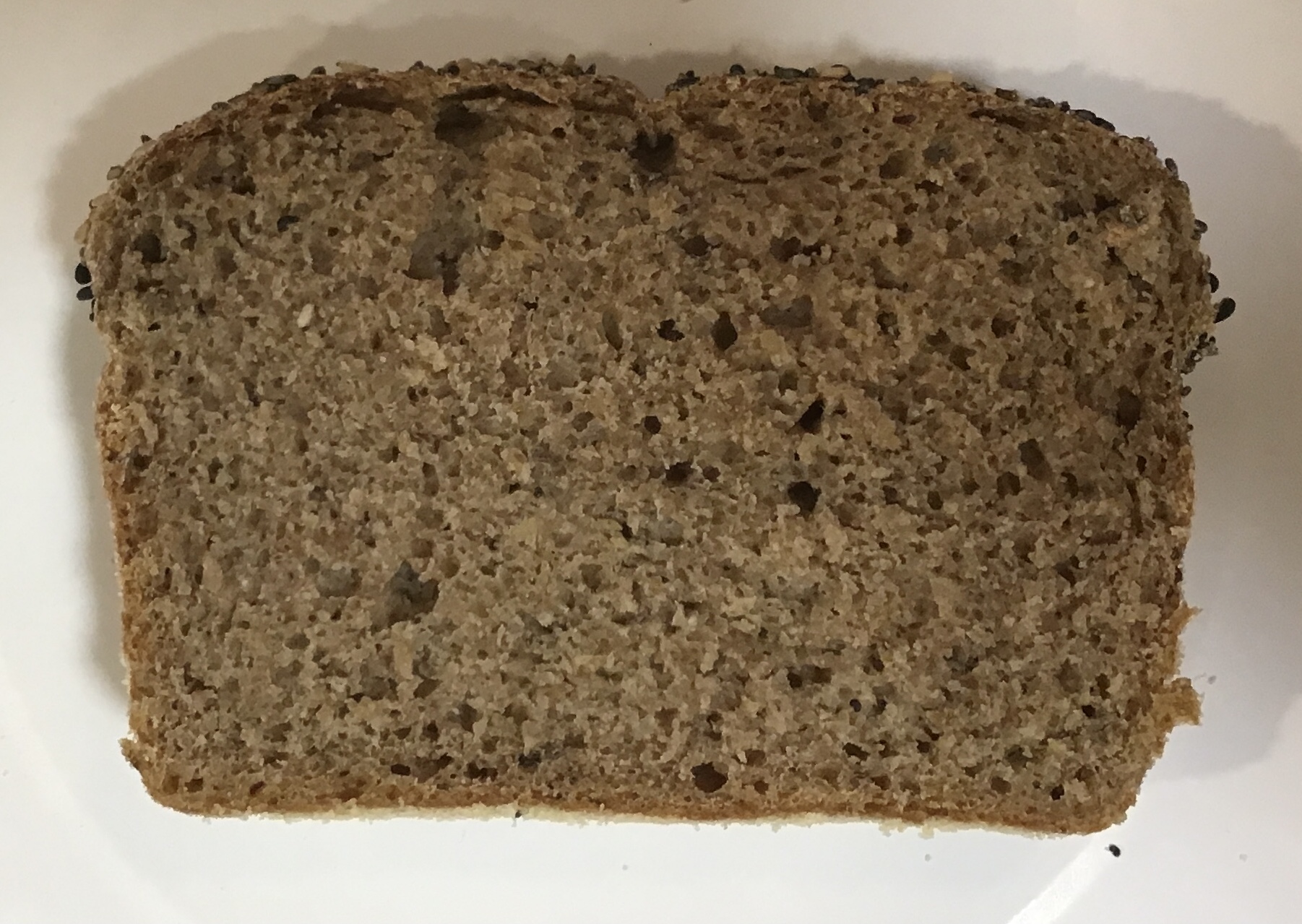
97th bake. 08/06/2022. WW, rye, BF, starter, IDY.

Aug. 6, 2022. 97th bake.
Oh my. This is the bread I've been looking for.
I couldn't wait and ate a slice before taking photos.
This is the 5th loaf in this series, (4 pan loaves, 1 boule) and I finally have it dialed in.
- 200 grams home-milled hard red winter wheat, whole grain. (Stored for 14 years. Purchased and vacuum packed in 2008.)
- 50 grams home-milled hard white spring wheat, whole grain. Circa 2018.
- 6.5 g salt.
- 210 g water.
- soak for about 1 hour. 10:23am to 11:30 am. (It was in fridge from 10:55 to 11:30.)
- 70 grams home-milled whole rye. Purchased 2021. 20% of 350 g total flour.
- this rye is kind of soft, so I felt it didn't need to go into the soaker.
- 7 g bread spice, weighed. This was about 4 tsp, which is more than I usually used, but I wanted to try 2% of flour after reading that figure somewhere.
- 14 g mix of ground flaxseed/chia. 4% of total flour.
- 15 g bread flour.
- 1/8 tsp Fleischmann instant dry yeast. Assuming 7 g yeast per 2.25 tsp.
7 / 2.25 / 8 = .389 g. .389 / 350 = .11 % IDY. - --- the above dry ingredients (rye through yeast) were mixed together.
- 25 g 100% hydration starter. 12.5 / 350 = 3.5 % PFF.
- 50 g water.
- --- starter was disolved in the water, then mixed with above dry ingredients at about 11:25 am.
- another 10 grams of water was added to the leavened part.
- water: 210 + 12.5 + 50 + 10 / 350 = 282.5 / 350 = 80.7 % hyd. Maybe should account for bread spice and ground flax/chia as they absorb water too.
- --- the soaker and the leavened part were mixed via kneading from 11:30 am to 11:40 am.
- --- kneaded a bit at 12:40 pm.
- --- kneaded a bit at 1:30 pm.
- --- kneaded a bit at 2:20 pm.
- --- at 2:30, dough was shaped and placed in oiled and dusted pan as below. (3 hour bulk ferment @ 78-80 F.)
- --- at 3:34, top of dough was wetted, then coated with seed mix.
- --- at 3:38, pan was covered in aluminum foil and placed in toaster oven, pre-heated to 450 F, thermostat was then lowered to 400 F. (68 min final proof @ 78-80 F.)
- --- at 3:57, aluminum foil cover was removed. (19 min)
- --- at 4:15, internal loaf temp was 188 F. Returned to oven.
- --- at 4:25, internal temp was 208.7 F. Called it done. Plopped it out on paper plate and chopsticks. 47 min total bake time.
- --- at 5:50 pm, couldn't resist, and cut off and ate a piece. Mmmm.
- Topping: brown sesame, black sesame, chia seeds, poppy seeds.
- Proofed and baked in Lodge cast iron loaf pan 4LP. Inside coated with coconut oil and dusted with durum semolina (the gritty stuff).
No added sugar! No oil, except what was in ground flaxseed/chia, the topping seeds, and the oil to coat the pan.
I'll fill in more of the details from my notes later on.
I seem to have fixed the problem of pale and weak top crust (in this toaster oven) by:
- Fermenting less.
- Putting aluminum foil over the pan for the first part of the bake.
- Using top-heat for the covered part of the bake, and for most, but not all of the uncovered part.
- This made the top crust darker and firmer than the previous attempts.
This loaf is moist and tasty. The bread spice and flax/chia in the dough make it good enough that I don't need to dip in flavored/seasoned oil at all.
There's no head-room to spare in this toaster oven, so I can't increase the height of the loaf. 350 g is the max amount of this type/mix of flour for this pan.







Comments
To finding the bread you are looking. Love at first bite:-) That is an important moment but you kind of spoiled the drama of what bread #100 would be!
I am curious as to how and when the IDY was added to the soaker?
Happy Baking
Thanks.
I updated the OP from notes.
Soak time of soaker was 1 hr 7 min. 10:23 am - 11:30 am.
Bulk ferment was 3 hours. 11:30 am - 2:30 pm.
Final proof in pan was 1 hr 8 min. 2:30 pm - 3:38 pm.
Total bake time was 47 min. (Pre-heated to 450 F, but baked at 400 F.) A 9" cordierite pizza stone was between the lower heating elements and the rack upon which the Lodge pan sat.
Of which: 19 min covered with both top and bottom elements activated. 28 minutes uncovered, of which maybe 10 minutes were bottom element only, and the last 18 minutes with top and bottom elements.
That looks great Dave, I'm glad you've honed in now on the bread you've been trying to bake. The success must feel and taste great!
Benny
The taste hasn't improved over time, like sourdough-leavened bread, and it's drying out quicker than the higher-hydration hearth breads.
But the half-day-bake convenience, and small eat-in-two-days size makes it worth it. A small family could polish this off in one sitting.
I love hearty breads like that. No sign of crumbliness, which is pretty impressive considering there are no added enrichments (outside of what's naturally in the seeds). Clever idea to grind them up. Looks like a winner to me. How's the shelf life?
–AG
I baked it Saturday afternoon, and I noticed it drying out Monday afternoon/evening, even-though I kept it sealed in a plastic bag.
I'm wondering if the seed topping "robbed" moisture from the rest of the bread. Or if the ground flax/chia stole moisture from the bread starch. I did not pre-soak the ground flax/chia, I just mixed it with the final dough dry ingredients (70 g rye, 15 g, bread flour, salt, IDY) before adding water and starter to that combo, then combined all that with the soaker.
Next time, I'll add/disperse the ground flax/chia into the soaker's water first, then add the soaker flour to that. That will let the flax/chia have first dibbs to however much water it wants, then adjust the water after adding the soaker's flour.
This concept of "what ingredient grabs and holds on to the water first" dawned on me when working with whole grain durum. I saw that if whole grain durum gets wetted first with more water than it needs, the bran part "locks in" the water, becomes super sticky, and never releases that water to less-hydrated ingredients.
The seed topping comes out of the oven kind of dry, but a day later I noticed those seeds had softened up some. I assume they slowly took moisture from the rest of the bread.
Dave, What are you using for your bread spice? Also, do you think Kamut would work as a replacement for the hard white wheat?
A batch of my bread spice is:
Toast the whole spices in a pan until aromatic. Let cool. Grind in a whirly spice/coffee grinder.
I originally got it from Hanseata. She used 1 part fennel, 1 part caraway, 2 parts coriander. Toasted first, then cooled, then ground. I split the fennel into 1/2 anise, 1/2 fennel.
--
Kamut is more like durum than common wheat. So I'd just use red wheat if you don't have white wheat. But, who knows, it may work even better.
Thanks!